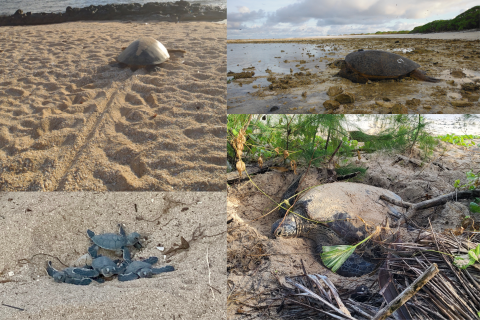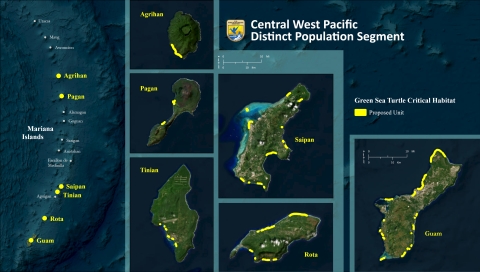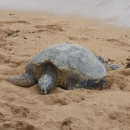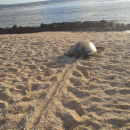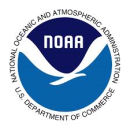The U.S. Fish and Wildlife Service (USFWS) is proposing to designate terrestrial critical habitat for five distinct population segments (DPS) of the green sea turtle (Chelonia mydas) — three Pacific DPS's: Central North Pacific (Hawaiian Archipelago), Central South Pacific (American Samoa and Palmyra Atoll), Central West Pacific (Marianas Archipelago), and two Atlantic DPS's: North Atlantic (Florida and Puerto Rico) and South Atlantic (U.S. Virgin Islands).
This webpage focuses on the three distinct population segments of the green sea turtle in the Pacific Islands region. The National Oceanic Atmospheric Administration's National Marine Fisheries Service (NMFS) is proposing to designate marine critical habitat for the green sea turtle concurrently with this proposed rule.
Learn more about the USFWS and NMFS proposed rules for critical habitat at the following links:
- USFWS Proposed Terrestrial Critical Habitat (Federal Register): Click Here
- Search Federal Docket Number “FWS- R4–ES–2022–0164”
- USFWS Proposed Terrestrial Critical Habitat Shapefiles: Click Here
- USFWS Proposed Terrestrial Critical Habitat Methodology: Click Here
- USFWS Proposed Terrestrial Critical Habitat Economic Impacts: Click Here
- NMFS Proposed Marine Critical Habitat: Click Here
- Joint USFWS-NMFS Press Release: Click Here
PUBLIC COMMENT
FREQUENTLY ASKED QUESTIONS
BACKGROUND
REGULATORY
Green sea turtles (hereinafter referred to as green turtle) were first listed under the Endangered Species Act (ESA) in 1978. In 2016, USFWS and NMFS used the best available scientific and commercial data on green turtles around the world to subdivide the circumglobal population into 11 distinct population segments (or DPSs).
Green turtle ESA status by Pacific DPS:
- Central North Pacific DPS - THREATENED
- Central South Pacific DPS - ENDANGERED
- Central West Pacific DPS - ENDANGERED
The ESA listing status above means that the green turtle is in danger of extinction, now or in the foreseeable future, throughout all or a significant portion of its range.
BIOLOGICAL
Green turtles are the largest hard-shelled sea turtles, growing to approximately 3 to 4 feet and weighing approximately 250 to 440 pounds. Female green turtles reach maturity between 25 to 35 years old, at which time they can reproduce.
Nests are laid in sandy beaches. Eggs will spend approximately two months incubating before hatchlings emerge and make their way to the water. Uniquely, green turtles in the Hawaiian archipelago bask on shorelines, where they emerge from the water onto exposed sandy beaches and low shelving reef rocks for an undetermined amount of time before returning to the water. The basking behavior is only documented in the Hawaiian Archipelago.
THREATS
In the terrestrial environments of the Pacific Islands, green turtle’s biggest threats are:
- Loss and degradation of nesting habitat from coastal development, artificial lighting, coastal armoring, and beach nourishment
- Climate change from effects to sand temperature, habitat inundation, and habitat loss
Green Sea Turtle Biology Infographic
Critical Habitat
Critical habitat is specific geographic areas that are essential for the conservation of a threatened or endangered species that affect only federal agency actions (including federally funded or permitted activities).
Critical habitat is a conservation tool to guide cooperation within the federal government and inform landowners and the public of areas that are important to a species’ conservation and recovery.
Critical habitat does not:
- Affect land ownership or allow the government to access, take or manage private property
- Create reserves or protected areas
- Prevent development
Learn more about CRITICAL HABITAT.
Green Sea Turtle Critical Habitat Process Infographic
Proposed Terrestrial Critical Habitat in the Pacific Islands
In the U.S. Pacific, the primary terrestrial green turtle habitats are in three DPSs that include the Hawaiian Archipelago to the north, Samoan Archipelago to the south, and the Mariana Archipelago to the west. We acknowledge and will use the respective indigenous culture's name for green turtle within each DPS.
Proposed Terrestrial Critical Habitat Shapefiles: Click Here
- Central North Pacific DPS (Hawaiian Archipelago)
- Honu (Green Turtle in Hawaiian)
- Central South Pacific DPS (Palmyra Atoll and Samoan Archipelago)
- Laumei Enaʻena (Green Turtle in Samoan)
- Central West Pacific DPS (Mariana Archipelago)
- Haggan (Green Turtle in CHamoru / Chamorro)
- Wong Mool (Green Turtle in Carolinian)
Central North Pacific Distinct Population Segment — Hawaiian Archipelago
Honu (green turtle) is listed as threatened in the Central North Pacific DPS under the Endangered Species Act. Designation of critical habitat will help focus federal, state, and local conservation efforts to manage and protect honu where they nest and bask. Approximately 17 percent of the proposed critical habitat overlaps with existing critical habitat for other species.
Hawaiian Archipelago: Approximately 1,050 acres of federal and state lands are proposed as critical habitat within the Northwestern Hawaiian Islands (Papahānaumokuākea) for nesting and basking honu. Papahānaumokuākea includes the islands and atolls of Hōlanikū (Kure Atoll), Kuaihelani (Midway Atoll), Manawai (Pearl and Hermes Atoll), Kapou (Lisianski Island), Kamole (Laysan Island), and Lalo (French Frigate Shoals). Approximately, 1,183 acres of federal, state, private and uncategorized lands are proposed as critical habitat within the Main Hawaiian Islands for nesting and basking honu. The Main Hawaiian Islands include the islands of Kauaʻi, Oʻahu, Molokaʻi, Maui, Lānaʻi, Kahoʻolawe, Hawaiʻi.
Central South Pacific Distinct Population Segment — Samoan Archipelago and Palmyra Atoll
Laumei enaʻena (green turtles) is listed as endangered in the Central South Pacific DPS under the Endangered Species Act. The Central South Pacific DPS includes Palmyra Atoll and the islands and atolls that are part of the Territory of American Samoa. Designation of critical habitat will help focus federal, territorial, and local conservation efforts to manage and protect green turtles where they nest. The proposed critical habitat does not overlap with existing critical habitat for other species.
Palmyra Atoll: Approximately 22 acres of federal and private lands are proposed as critical habitat for nesting green turtles on the islands of Strawn, Cooper, and Aviation.
Samoan Archipelago: Approximately 220 acres of federal, territorial, private, and uncategorized lands are proposed as critical habitat for nesting laumei enaʻena on the islands and atolls of Swains, Ofu, Olosega, Taʻu, Aunuʻu, and Motu o Manu (Rose Atoll).
Central West Pacific Distinct Population Segment — Mariana Archipelago
Haggan and wong mool (green sea turtle in CHamoru/Chamorro and Carolinian, respectively) is listed as endangered in the Central West Pacific DPS under the Endangered Species Act. Designation of critical habitat will help focus federal, territorial or commonwealth, and local conservation efforts to manage and protect green sea turtles where they nest. Approximately eight percent of the proposed critical habitat overlaps with existing critical habitat for other species.
Territory of Guam: Approximately 125 acres of federal, territorial, private, and uncategorized lands are proposed as critical habitat for nesting haggan and wong mool.
Commonwealth of the Northern Mariana Islands: Approximately 180 acres of commonwealth, private, and uncategorized lands are proposed as critical habitat for nesting haggan and wong mool on the islands of Agrihan, Pagan, Saipan, Tinian, and Rota.
Public Comment:
The public comment period for this proposed rule has CLOSED.
The proposed critical habitat designation was available for public comment for 90 days beginning on July 19, 2023, and concluding on October 17, 2023 11:59 PM Eastern time.
During this time, the public was invited to submit written comments electronically or by mail, and orally during four public hearings in the Pacific Islands which were jointly held by USFWS and NMFS in the month of August. The meeting in Hawaiʻi was held virtually, while meetings in American Samoa, Guam, and Saipan were held in-person. Information for each Pacific Islands public meeting can be found below.
In consideration of the natural disaster impacts from Typhoon Mawar and the Maui wildfires, we continue to invite questions and inquiries via email following the closure of the public comment period to accommodate information needs.
The Service thanks all who had submitted written and oral comments during the comment period. All received comments will be fully considered by the Service before any final rule is published.
Pacific Islands Contacts: Keelan Barcina, species classification biologist, Pacific Islands Fish and Wildlife Office, by email at keelan_barcina@fws.gov; or Lindsy Asman, listing and classification team manager, Pacific Islands Fish and Wildlife Office, by email at lindsy_asman@fws.gov.
Hawaiʻi Virtual Public Meeting & Hearing (Central North Pacific DPS)
Virtual Meeting | August 10, 2023
Virtual Meeting Presentation: Click Here
Q&A and public hearing transcription is available upon request
Tutuila Public Meeting & Hearing (South Central Pacific DPS)
- Governor Rex H. Lee Auditorium, Tutuila | August 16, 2023
- Meeting Presentation: Click Here
- Q&A and public hearing transcription is available upon request
Guam Public Meeting & Hearing (Central West Pacific DPS)
- Hilton Guam Resort and Spa | August 21, 2023
- Meeting Presentation: Click Here
- Q&A and public hearing transcription is available upon request
Saipan Public Meeting & Hearing (Central West Pacific DPS)
- Crowne Plaza Resort Saipan | August 23, 2023
- Meeting Presentation: Click Here
- Q&A and public hearing transcription is available upon request
Atlantic Region Virtual Public Meeting & Hearing
- Virtual Meeting | August 29, 2023
- Virtual Meeting Presentation Slides: Click Here
- For more information about the Atlantic Region meeting contact Lourdes Mena, classification and recovery division manager, (904) 731–3134
- Q&A and public hearing transcription is available upon request
Frequently Asked Questions:
Q: What is critical habitat?
A: Critical habitat includes geographic areas containing features essential for the conservation of a listed species that may require special management considerations or protection. Federal agencies are required to consult with the Fish and Wildlife Service and NOAA Fisheries if actions they authorize, fund, or carry out may affect critical habitat. Federal agencies are also required to ensure actions they authorize, fund, or carry out do not destroy or adversely modify critical habitat.
Specifying the location of habitat essential for the conservation of the species helps federal agencies identify where to use their authorities to benefit listed species. The designation also helps focus the conservation efforts of other conservation partners, such as state and local governments, non-governmental agencies, and individuals.
Q: Why are green sea turtles listed under the ESA?
A: Historically, green turtles were killed for their meat and eggs, leading to global population declines. Today, the species faces an array of risks, including threats to its habitat. Coastal development impacts the beaches they need to nest and increases artificial lighting, causing hatchlings to migrate toward the lights and away from the ocean. Runoff and other pollution kill seagrass and algae, reducing the availability of these major food sources for green sea turtles. Dredging impacts these food resources and disturbs the rocks, reefs, and troughs where green turtles rest and may result in the direct take of the species. In-water construction may also block migration or access to nesting beaches.
Climate change also imperils green sea turtles as rising seas and storms erode beaches and flood nests, causing them to wash away. Higher sand temperatures can increase the number of female hatchlings, shifting the ratio of males and females. Changes in ocean temperature alter the amount and distribution of food, upsetting their migration, foraging range, and nesting seasons.
Q: What are distinct population segments?
A: A distinct population segment (DPS) is discrete from other populations of that species and significant in relation to the entire species, as a whole. Under the ESA, a DPS classification is reserved for vertebrates. We identified and listed 11 green turtle DPSs in 2016. Within U.S. jurisdiction, there are six DPS's (along with their ESA listing status): North Atlantic (threatened), South Atlantic (threatened), East Pacific (threatened), Central North Pacific (threatened), Central South Pacific (endangered), and Central West Pacific (endangered). The East Pacific DPS off the coast of California does not nest within U.S. jurisdiction; however, because the DPS relies on marine habitat within U.S. jurisdiction, NMFS is proposing marine critical habitat for the East Pacific DPS.
Q: What habitat features do green turtles depend on for nesting?
A: Female green turtles need to be able to emerge from the water onto and travel across the beach to access sandy area above the high tideline to lay their nest and return to the water. The sandy beach environment needs to support development of embryos, hatching of eggs, hatchlings emerging from eggs and emerging from the sand, and hatchlings traveling across the beach to the ocean. Sufficient darkness is important to ensure that nesting turtles are not deterred from emerging onto beaches, and hatchlings and post-nesting females can orient to the sea.
Q: Why is this critical habitat necessary?
A: Green sea turtles are an important part of our communities, not only for the ecological and cultural roles fulfilled within their native ecosystems. Critical habitat is being proposed to ensure that this species is kept from extinction, so that their populations and connection with current and future generations will continue to endure.
Q: How does critical habitat affect me?
A: Critical habitat designations affect only Federal agency actions or federally funded or permitted activities. Critical habitat designations do not affect activities by private landowners if there is no Federal “nexus”—that is, no Federal funding, permit, or license involved. Federal agencies are required to avoid “destruction” or “adverse modification” of designated critical habitat. Federal agencies work with the Service to amend their projects, enabling it to proceed without adversely affecting critical habitat. Most federal projects are likely to go forward, but some may be modified to minimize harm.
Critical habitat does not prevent all development or other activities that occur in a designated area. Critical habitat does not affect private land ownership or activities if there is no federal nexus. Critical habitat does not mandate government or public access to private lands; and does not establish a refuge, wilderness reserve, preserve, or other special conservation area conservation area
A conservation area is a type of national wildlife refuge that consists primarily or entirely of conservation easements on private lands. These conservation easements support private landowner efforts to protect important habitat for fish and wildlife and major migration corridors while helping to keep agricultural lands in production.
Learn more about conservation area .
Q: What kind of comments are we looking for?
A: The Service is requesting comments or information from other governmental agencies, indigenous communities and organizations, the scientific community, industry, or other interested parties concerning the proposed critical habitat designation for green sea turtle.
The Service particularly seeks comments on nesting and basking for the islands in the Central North Pacific DPS (Hawaiian Archipelago) ; nesting in the Central South Pacific DPS (Palmyra Atoll; Swains Island, American Samoa, Rose Atoll), and nesting in the Central West Pacific DPS (Mariana Archipelago) concerning, but not limited to:
- Amount and distribution of green turtle basking habitat in the Central North Pacific DPS and nesting habitat in all DPS referred to in this rule
- Amount and distribution of green turtle nesting habitat
- Nesting areas that should be included boundary modifications
- Land use designations, current or planned activities in proposed areas and their impacts on proposed critical habitat
- Projected impacts of climate change climate change
Climate change includes both global warming driven by human-induced emissions of greenhouse gases and the resulting large-scale shifts in weather patterns. Though there have been previous periods of climatic change, since the mid-20th century humans have had an unprecedented impact on Earth's climate system and caused change on a global scale.
Learn more about climate change on nesting habitat - Benefits of excluding a proposed area; probable economic, national security impacts
See Information Requested, in SUPPLEMENTARY INFORMATION section of the proposed rule for more information.
Q: What will happen after I have provided public comment?
A: All comments received during the four public hearings and the open comment period will be fully considered by the Service before any final rule is published. The final critical habitat designation rule, including boundaries, will publish in the Federal Register, typically one year after the proposed rule is published.
Electronic and written comments must be received or postmarked on or before October 17, 2023 11:59 p.m. Eastern time (Oct. 18, 1:59 p.m. CHamoru/Chamorro time / Oct. 17, 5:59 p.m. Hawaiʻi time / Oct. 17, 4:59 p.m. Samoan time).
See Public Hearing, in SUPPLEMENTARY INFORMATION section, of the proposed rule for more information.
Q: Where can more information on green sea turtles be found?
A: Visit the Service and NOAA Fisheries websites for more information about the green sea turtle.

